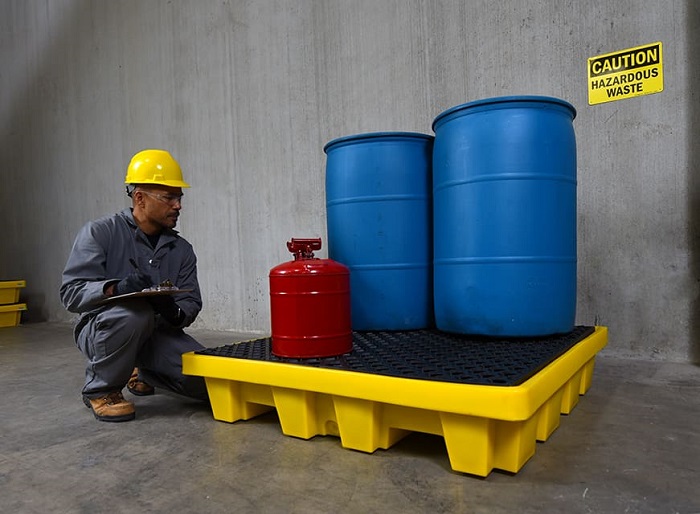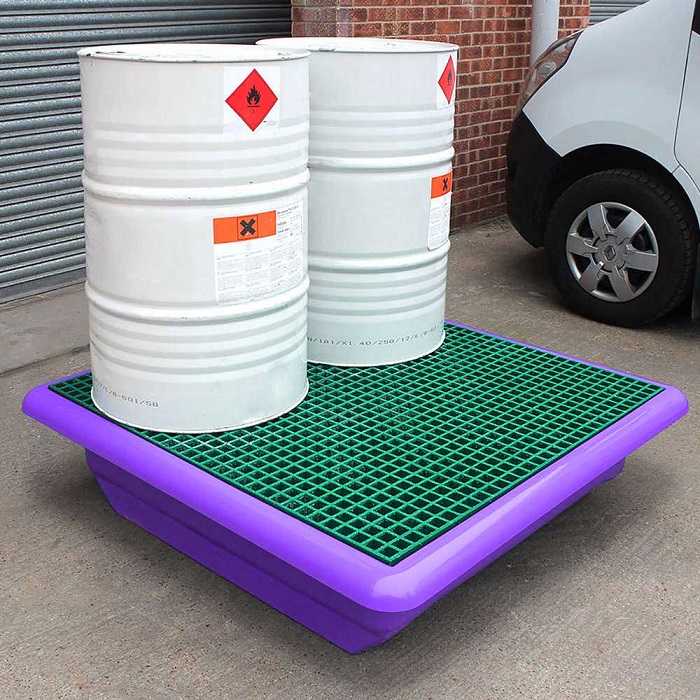Raw material processors, manufacturers, and even farmers understand the nuances associated with storing and handling pallet-sized volumes of liquids and bulk commodities. Most of them are as dangerous as they are expensive; and depending on the commodity, even small amounts of loss or leakage can have costly, or potentially catastrophic consequences.
That’s why it’s so important for bulk consumers to have effective containment and spillage control practices in place before taking possession of these commodities. More than anything, they need to be sure that they can be stored and protected from unintentionally seeping, or being discharged into the environment; that makes it a process that has to begin with the storage containers themselves.
Fortunately, there’s an entire range of industrial-grade bulk containment containers available for all types of commodity storage containers. They’re designed specifically to provide multi-level containment, and they’re the first and most crucial step any company can take toward addressing bulk storage safety compliance concerns.
Bunded Pallets Help Protect the Environment and the Bottom Line

Make no mistake: regardless of the operating environment, there’s no margin for error when working with Class 3, 5, 6, or 8 bulk commodities. They can be hazardous as well as dangerous, which is why intermediate bulk container (IBC) bunded pallet containers are the only choice for ensuring that they can be safely stored and handled. Along with IBCs, these durable bunding pallets are also designed to accommodate drums and barrels; and they come in a range of sizes and capacities that makes them easy to deploy, and straightforward to load or move into position with a pallet jack or forklift.
Australian Standards (ASs) 1940-2004 and 3833-2007 prescribe the groundwork for safety and compliance when it comes to the storage and handling of bulk quantities of flammable and toxic liquids, and corrosion-resistant bund pallets are the first line of containment against their unintended release. The incentive for using IBC storage bunds goes beyond just spill containment though, as they also feature a selection of cost-saving benefits that include:
- The ability to recover and reuse products that would otherwise be lost to spillage;
- The possibility to organize larger, more efficiently organized bulk storage areas; and,
- The opportunity to more efficiently secure bulk commodities.
Bunding effectively allows commodity consumers to exercise maximum regulatory control over their bulk liquids, while reducing the costs that are tied to waste and unrecoverable resources. A bund is more than just an oversized IBC drip tray: it’s an asset that protects the consumer’s bottom line.
Protect All Your Commodities From Loss or Spillage

High-quality industrial bunds with integrated frames are typically constructed from both high-density polyethylene or heavy-duty zinc galvanized steel, and they provide optimal, leak-proof resistance against a host of hazardous and toxic liquids, including:
- Flammable and reactive distillates, such as petroleum and diesel fuels;
- Chemical-based solvents and detergents, and waste liquids; and,
- Agricultural compounds, such as insecticides and herbicides.
Sturdy bunded pallets can even be used in food-grade, and pharmaceutical environments to contain and manage the loss of costly, and highly controllable ingredients and substances. And with framed PVC covers, bunds can also be outfitted for fume ventilation when used indoors, or fully protected from rain or dust intrusion when used outdoors.
Bund Pallet Capacities That Exceed Expectations

Containment capacity is the core attribute of every IBC bunded pallet, and modern bunds are built to make handling large volumes convenient. As a general rule, every IBC bund needs to be capable of holding 110% of the capacity that it’s expected to support; and with standard-sized IBCs boasting volumes of 1000ltrs, bund holding volumes of 1150 – 1250ltrs are an essential part of ensuring that even if an IBC were to suffer a valve failure or total breach from a forklift, that its full contents can still be contained.
That’s a key aspect of why IBC bunding configurations are so extensive, to include suitable arrangements for:
- 1 x 1000ltr IBC, or 2 x 208ltr drums;
- 2 x 1000ltr IBC, or 4 x 208ltr drums; or,
- 1 x 1000ltr IBC, together with 2 x 208ltr drums.
Critically, it’s this degree of flexibility that makes IBC binds such superior containment equipment. They aren’t just for IBCs; they’re equally effective with other types of reusable liquid and bulk storage containers as well, including:
- All sizes of drums and barrels;
- Bins and totes; and,
- Flexible tanks and bladders.
And not only do storage bunds prevent accidental spills and ruptures from escalating into hazardous releases, they also help to provide a necessary degree of separation between commodities. It doesn’t seem like a big concern, but it is, and bunds are the perfect containers to make it possible.
Keeping Commodity Compliance in a Container With Bunds
No matter which type of operation they’re used for, or whether they’re a part of an indoor or outdoor activity, there’s a broad array of commodities that shouldn’t be stored together. And while this would ordinarily be true in any environment where there’s a potential for product cross-contamination, it’s especially true with incompatible flammable and toxic hazard substances which, in compliance with AS3833-2007, require physical separation.
When it comes to segregation distances, even in the event of accidental spillage, IBC bunded storage is the best possible solution for:
- Keeping incompatible substances completely confined to controllable areas;
- Preventing unintended commingling when multiple commodities of the same class are stored together; and,
- Enabling greater all-around accountability for highly valuable bulk liquids.
And with the aide of an IBC dispensing tray, bunding users are able to reduce their exposure to cross-contamination and risk exposure even further.
The Final Word
At the end of the day, any business that handles and utilizes hazardous or dangerous bulk commodities needs to have procedures in place that prevent unintended product releases or commingling. Even one incident can turn out to be one incident too many, so safeguards have to be initiated throughout the work process, especially at the point of storage.
IBC bunded pallet containers are the best way to ensure bulk products are stored and handled safely. They’re a simple, no-nonsense approach to safety compliance that can even save commodity consumers money on their material usage.












